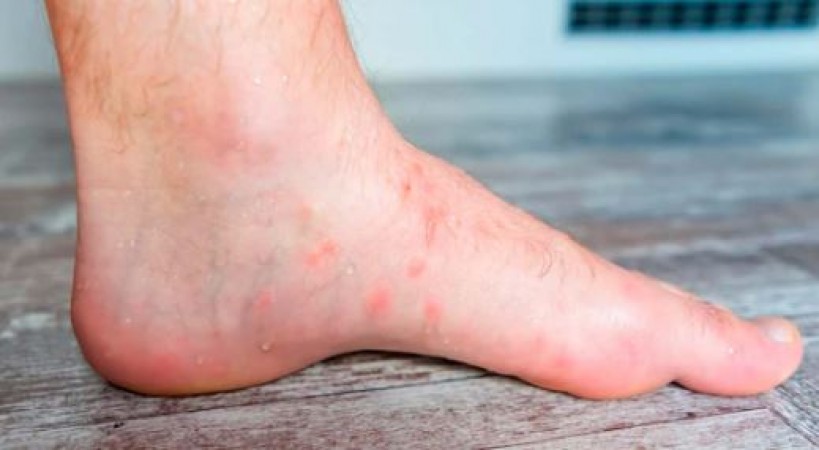
Monsoon brings much-needed relief from the heat, but it also brings challenges for our skin, particularly our feet. Rainwater can lead to various skin problems, especially fungal infections. The combination of moisture, dirt, and bacteria creates the perfect environment for infections to thrive. If not addressed promptly, these issues can escalate, leading to discomfort and even more severe health concerns. Here’s a detailed guide on how to protect your feet from fungal infections during the rainy season.
Why Does Rainwater Cause Fungal Infections?
During the monsoon, the increased humidity and constant exposure to rainwater create an environment where fungi can easily grow. When your feet are continuously exposed to moisture, especially in damp shoes or socks, they become susceptible to infections. Fungal infections, such as athlete's foot, can cause symptoms like itching, redness, burning sensations, and in severe cases, blisters and peeling skin. If the infection spreads to the nails, it can lead to a condition called onychomycosis, where the nails become discolored, thickened, and brittle.
Common Symptoms of Fungal Infections in Feet
Itching and Redness: Initial symptoms usually include persistent itching and redness, particularly between the toes.
Burning Sensation: As the infection progresses, you might experience a burning sensation in the affected areas.
Peeling or Cracking Skin: The skin may start to peel or crack, especially in areas that remain damp for extended periods.
Discolored Nails: If the infection spreads to the nails, they may turn yellow, white, or brown and become thick or brittle.
Unpleasant Odor: Fungal infections often cause a noticeable odor, especially if the feet remain damp for too long.
How to Prevent Fungal Infections from Rainwater
1. Maintain Proper Hygiene
Regular Washing: Wash your feet thoroughly with soap and water, especially after exposure to rainwater. Dry them completely, paying extra attention to the areas between the toes.
Keep Feet Dry: Moisture is the primary enemy when it comes to preventing fungal infections. Ensure your feet are always dry. After washing or getting wet, dry your feet thoroughly with a clean towel.
2. Choose the Right Footwear
Breathable Footwear: Opt for sandals or open-toed shoes that allow air circulation, reducing the chances of moisture build-up. Avoid closed shoes as much as possible during the rainy season.
Waterproof Shoes: If you must wear closed shoes, choose waterproof ones that prevent rainwater from seeping in. Ensure that the shoes are thoroughly dried before the next use.
Change Socks Regularly: If your socks get wet, change them immediately. Use socks made of moisture-wicking materials to keep your feet dry.
3. Use Antifungal Powders and Creams
Antifungal Powders: Applying antifungal powder to your feet before wearing shoes can help absorb moisture and prevent fungal growth.
Medicated Creams: If you notice the early signs of a fungal infection, use an antifungal cream to treat the affected area. Early intervention can prevent the infection from spreading.
4. Natural Remedies
Coconut Oil: Coconut oil has antifungal and moisturizing properties. Apply it to your feet, especially between the toes, before going to bed. It helps keep the skin soft and prevents cracks where fungi can grow.
Aloe Vera Gel: Aloe vera is known for its soothing and healing properties. Applying aloe vera gel can help reduce inflammation and prevent infection. It’s particularly useful if you already have cuts or irritation from rainwater.
Vinegar Soak: Soaking your feet in a mixture of vinegar and water (one part vinegar to two parts water) for 15-20 minutes can help fight off fungal infections. Vinegar’s acidic nature helps balance the pH of the skin, making it inhospitable for fungi.
Neem Leaves: Neem leaves have potent antifungal and antibacterial properties. Boil neem leaves in water, let it cool, and soak your feet in this solution. It helps in soothing the skin and preventing infections.
5. Avoid Prolonged Exposure to Dampness
Dry Feet Quickly: If your feet get wet, dry them immediately. Carry a small towel with you during the monsoon to dry your feet whenever necessary.
Limit Time in Damp Conditions: Avoid walking in waterlogged areas. If you must, try to limit the time your feet are exposed to wet conditions.
Treating Fungal Infections if They Occur
Despite all precautions, if you still develop a fungal infection, prompt treatment is essential. Here are the steps you should take:
Clean the Affected Area: Wash the infected area with mild soap and water. Pat it dry gently, ensuring it’s completely dry.
Apply Antifungal Cream: Use an over-the-counter antifungal cream as directed. Common ingredients include clotrimazole, miconazole, and terbinafine.
Keep Feet Dry: Continue to keep your feet dry and clean to prevent the infection from worsening.
Seek Medical Attention: If the infection does not improve within a week or spreads to other areas, consult a healthcare professional. Severe cases may require prescription-strength medications or oral antifungals.
Celebrating National Nutrition Week 2024: A Guide to Healthier Eating
Ayush Minister Prataprao Jadhav Opens Delhi Health Expo, Announces National Screening Program
How Excessive Consumption of Tea and Coffee Can Be Harmful
Monsoon brings with it the risk of fungal infections, particularly in the feet. However, with proper care and hygiene, you can prevent these infections and keep your feet healthy. Regular washing, keeping your feet dry, choosing the right footwear, and using natural remedies like coconut oil, aloe vera, and neem can go a long way in preventing fungal infections. If you do notice any signs of infection, treat them promptly to avoid complications. By following these steps, you can enjoy the rainy season without worrying about your feet.